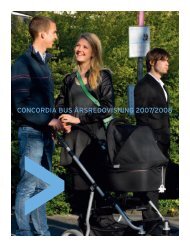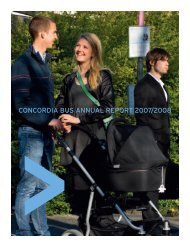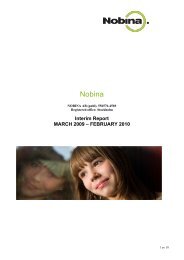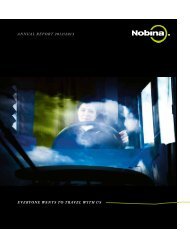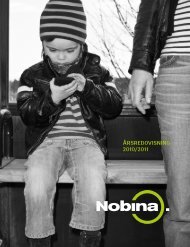Annual Report 2010/2011 - pdf 7.05 MB - Nobina AB
Annual Report 2010/2011 - pdf 7.05 MB - Nobina AB
Annual Report 2010/2011 - pdf 7.05 MB - Nobina AB
You also want an ePaper? Increase the reach of your titles
YUMPU automatically turns print PDFs into web optimized ePapers that Google loves.
MArKet OVerVIeW<br />
public transport – an everyday event<br />
<strong>Nobina</strong> operates in a growing market in transition; public transport has never<br />
been more right. More and more people choose to travel by bus because it<br />
saves time, money and the environment. traffic companies gain more control<br />
over how traffic is designed and tomorrow’s winners are the players who can<br />
offer an attractive, affordable and profitable product to their customers.<br />
THE Traffic TrEND<br />
A GROWING MARKET<br />
<strong>Nobina</strong>’s largest market is in metropolitan<br />
regions. The majority of people choose the<br />
bus sometimes and about 25% use public<br />
transport every day. Women travel by bus<br />
more often than men, while young people<br />
and pensioners travel by bus most frequently.<br />
The Nordic market for public transport by<br />
bus is expected to grow over the coming years<br />
and generated around SEK 44 billion in <strong>2010</strong>,<br />
of which regional traffic accounted for nearly<br />
90% and interregional traffic for slightly<br />
more than 10%.<br />
THE PublIc TRANsPORT TREND Is GROWING,<br />
buT cHANGING HAbITs TAKEs TIME<br />
Environmental considerations, leisure time<br />
and personal finances make bus or train<br />
transport more attractive than driving. Just<br />
five passengers on a bus, irrespective of fuel,<br />
has already contributed to reducing our environmental<br />
impact. But despite the fact that<br />
cars are expensive, create congestion and<br />
have a negative impact on the environment,<br />
driving is increasing at a faster rate than bus<br />
traffic, due to the convenience, in all areas<br />
except metropolitan regions. Most people<br />
who do not use public transport do not know<br />
how public transport works or where it operates.<br />
Prejudices about travel times and disruptions<br />
make the threshold high. Efforts by<br />
politicians and traffic companies have not<br />
managed to increase the market share for<br />
public transport, which has remained at<br />
10 NOBINA | ANNuAl repOrt <strong>2010</strong>/<strong>2011</strong><br />
about 20% for decades. But a joint change<br />
processes is currently taking place.<br />
A doubling of public transport would<br />
reduce the carbon emissions of passenger<br />
traffic by more than 20% and provide an<br />
economic gain of more than SEK 4 billion.<br />
In early 2008, a united public transport<br />
industry thus presented its ambition to<br />
double the market share of public transport<br />
in the short term, and to double the overall<br />
travel by public transport by 2020 to the<br />
Ministry of Enterprise, Energy and Communications.<br />
In spring 2008, industry associations<br />
presented a joint action plan to the<br />
government, after which doubling work<br />
proceeded with full force through various<br />
sub-projects.<br />
PRIcING AND PRODucT DEVElOPMENT<br />
When times are tough, it is difficult for<br />
the government, municipalities and county<br />
councils to achieve a balanced budget, which<br />
reduces opportunities for public transport<br />
to receive higher appropriations. Economic<br />
development also affects the funding of<br />
buses, which accounts for around 40% of<br />
the costs in contracts. All buses in the market<br />
today are custom-built since requirements<br />
vary from one client to another, and the<br />
continued low number of competing bus<br />
suppliers has a negative impact on pricing<br />
and product development.<br />
In <strong>2010</strong>, several international traffic<br />
companies showed low or negative profitability<br />
in their Nordic operations. All players<br />
expect that the price scenario in the Nordic<br />
region will improve for traffic companies.<br />
» environmental considerations,<br />
leisure<br />
time and personal<br />
finances make bus or<br />
train transport more<br />
attractive than driving.



